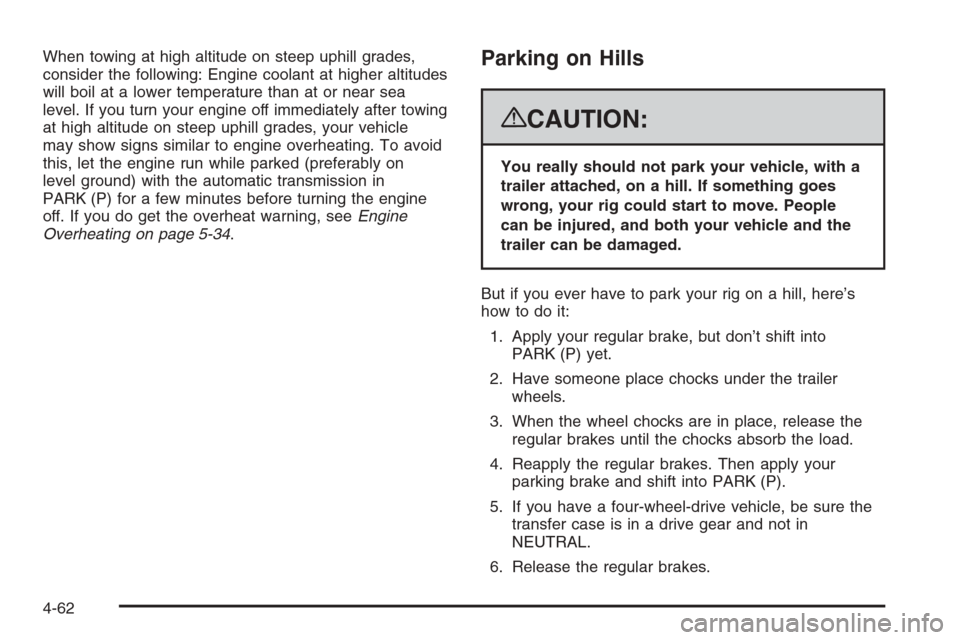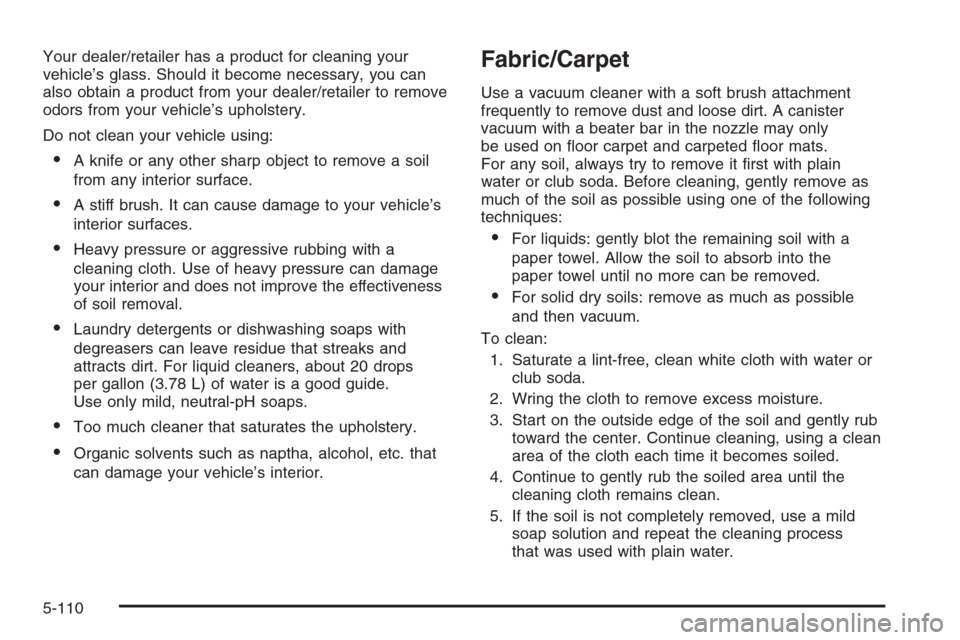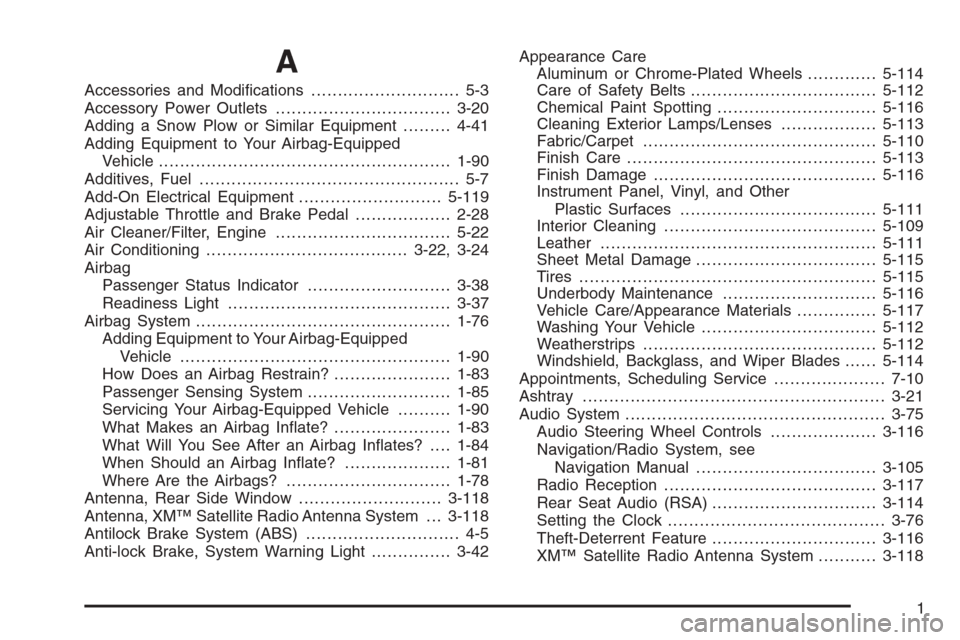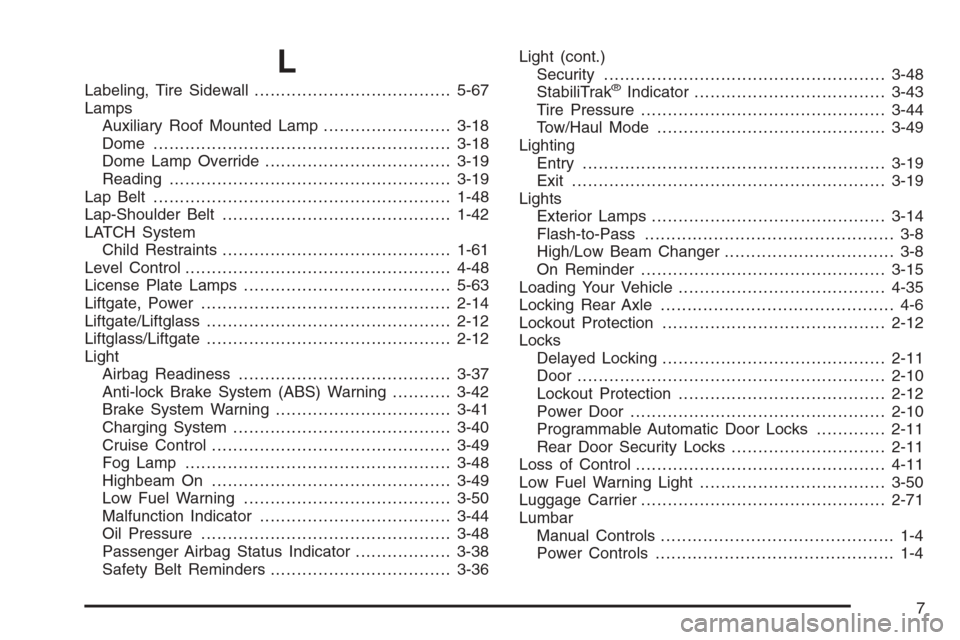2008 CHEVROLET SUBURBAN ABS
[x] Cancel search: ABSPage 341 of 538

Autoride®
If equipped, the Autoride system is fully automatic and
uses a computer controller to continuously monitor
vehicle speed, wheel to body position, lift/dive and
steering position of the vehicle. The controller then
sends signals to each shock absorber to independently
adjust the damping level to provide the optimum
vehicle ride.
Autoride also interacts with the tow/haul switch that,
when engaged, will provide additional control of
the shock absorbers. This additional control results in
better ride and handling characteristics when the vehicle
is loaded or towing a trailer. SeeTow/Haul Mode
Light on page 3-49for more information.
Towing a Trailer
Do not tow a trailer during break-in. SeeNew Vehicle
Break-In on page 2-24for more information.
{CAUTION:
If you do not use the correct equipment and
drive properly, you can lose control when you
pull a trailer. For example, if the trailer is too
heavy, the brakes may not work well — or even
at all. You and your passengers could be
seriously injured. You may also damage your
vehicle; the resulting repairs would not be
covered by your warranty. Pull a trailer only if
you have followed all the steps in this section.
Ask your dealer/retailer for advice and
information about towing a trailer with your
vehicle.
Notice:Pulling a trailer improperly can damage
your vehicle and result in costly repairs that would
not be covered by your warranty. Always follow
the instructions in this section and check with your
dealer/retailer for more information about towing
a trailer with your vehicle.
To identify the trailering capacity of your vehicle, you
should read the information in “Weight of the Trailer” that
appears later in this section.
4-49
Page 354 of 538

When towing at high altitude on steep uphill grades,
consider the following: Engine coolant at higher altitudes
will boil at a lower temperature than at or near sea
level. If you turn your engine off immediately after towing
at high altitude on steep uphill grades, your vehicle
may show signs similar to engine overheating. To avoid
this, let the engine run while parked (preferably on
level ground) with the automatic transmission in
PARK (P) for a few minutes before turning the engine
off. If you do get the overheat warning, seeEngine
Overheating on page 5-34.Parking on Hills
{CAUTION:
You really should not park your vehicle, with a
trailer attached, on a hill. If something goes
wrong, your rig could start to move. People
can be injured, and both your vehicle and the
trailer can be damaged.
But if you ever have to park your rig on a hill, here’s
how to do it:
1. Apply your regular brake, but don’t shift into
PARK (P) yet.
2. Have someone place chocks under the trailer
wheels.
3. When the wheel chocks are in place, release the
regular brakes until the chocks absorb the load.
4. Reapply the regular brakes. Then apply your
parking brake and shift into PARK (P).
5. If you have a four-wheel-drive vehicle, be sure the
transfer case is in a drive gear and not in
NEUTRAL.
6. Release the regular brakes.
4-62
Page 468 of 538

Your dealer/retailer has a product for cleaning your
vehicle’s glass. Should it become necessary, you can
also obtain a product from your dealer/retailer to remove
odors from your vehicle’s upholstery.
Do not clean your vehicle using:
A knife or any other sharp object to remove a soil
from any interior surface.
A stiff brush. It can cause damage to your vehicle’s
interior surfaces.
Heavy pressure or aggressive rubbing with a
cleaning cloth. Use of heavy pressure can damage
your interior and does not improve the effectiveness
of soil removal.
Laundry detergents or dishwashing soaps with
degreasers can leave residue that streaks and
attracts dirt. For liquid cleaners, about 20 drops
per gallon (3.78 L) of water is a good guide.
Use only mild, neutral-pH soaps.
Too much cleaner that saturates the upholstery.
Organic solvents such as naptha, alcohol, etc. that
can damage your vehicle’s interior.
Fabric/Carpet
Use a vacuum cleaner with a soft brush attachment
frequently to remove dust and loose dirt. A canister
vacuum with a beater bar in the nozzle may only
be used on �oor carpet and carpeted �oor mats.
For any soil, always try to remove it �rst with plain
water or club soda. Before cleaning, gently remove as
much of the soil as possible using one of the following
techniques:
For liquids: gently blot the remaining soil with a
paper towel. Allow the soil to absorb into the
paper towel until no more can be removed.
For solid dry soils: remove as much as possible
and then vacuum.
To clean:
1. Saturate a lint-free, clean white cloth with water or
club soda.
2. Wring the cloth to remove excess moisture.
3. Start on the outside edge of the soil and gently rub
toward the center. Continue cleaning, using a clean
area of the cloth each time it becomes soiled.
4. Continue to gently rub the soiled area until the
cleaning cloth remains clean.
5. If the soil is not completely removed, use a mild
soap solution and repeat the cleaning process
that was used with plain water.
5-110
Page 525 of 538

A
Accessories and Modi�cations............................ 5-3
Accessory Power Outlets.................................3-20
Adding a Snow Plow or Similar Equipment.........4-41
Adding Equipment to Your Airbag-Equipped
Vehicle.......................................................1-90
Additives, Fuel................................................. 5-7
Add-On Electrical Equipment...........................5-119
Adjustable Throttle and Brake Pedal..................2-28
Air Cleaner/Filter, Engine.................................5-22
Air Conditioning......................................3-22, 3-24
Airbag
Passenger Status Indicator...........................3-38
Readiness Light..........................................3-37
Airbag System................................................1-76
Adding Equipment to Your Airbag-Equipped
Vehicle...................................................1-90
How Does an Airbag Restrain?......................1-83
Passenger Sensing System...........................1-85
Servicing Your Airbag-Equipped Vehicle..........1-90
What Makes an Airbag In�ate?......................1-83
What Will You See After an Airbag In�ates?....1-84
When Should an Airbag In�ate?....................1-81
Where Are the Airbags?...............................1-78
Antenna, Rear Side Window...........................3-118
Antenna, XM™ Satellite Radio Antenna System . . . 3-118
Antilock Brake System (ABS)............................. 4-5
Anti-lock Brake, System Warning Light...............3-42Appearance Care
Aluminum or Chrome-Plated Wheels.............5-114
Care of Safety Belts...................................5-112
Chemical Paint Spotting..............................5-116
Cleaning Exterior Lamps/Lenses..................5-113
Fabric/Carpet............................................5-110
Finish Care...............................................5-113
Finish Damage..........................................5-116
Instrument Panel, Vinyl, and Other
Plastic Surfaces.....................................5-111
Interior Cleaning........................................5-109
Leather....................................................5-111
Sheet Metal Damage..................................5-115
Tires........................................................5-115
Underbody Maintenance.............................5-116
Vehicle Care/Appearance Materials...............5-117
Washing Your Vehicle.................................5-112
Weatherstrips............................................5-112
Windshield, Backglass, and Wiper Blades......5-114
Appointments, Scheduling Service.....................7-10
Ashtray.........................................................3-21
Audio System.................................................3-75
Audio Steering Wheel Controls....................3-116
Navigation/Radio System, see
Navigation Manual..................................3-105
Radio Reception........................................3-117
Rear Seat Audio (RSA)...............................3-114
Setting the Clock.........................................3-76
Theft-Deterrent Feature...............................3-116
XM™ Satellite Radio Antenna System...........3-118
1
Page 531 of 538

L
Labeling, Tire Sidewall.....................................5-67
Lamps
Auxiliary Roof Mounted Lamp........................3-18
Dome ........................................................3-18
Dome Lamp Override...................................3-19
Reading.....................................................3-19
Lap Belt........................................................1-48
Lap-Shoulder Belt...........................................1-42
LATCH System
Child Restraints...........................................1-61
Level Control..................................................4-48
License Plate Lamps.......................................5-63
Liftgate, Power...............................................2-14
Liftgate/Liftglass..............................................2-12
Liftglass/Liftgate..............................................2-12
Light
Airbag Readiness........................................3-37
Anti-lock Brake System (ABS) Warning...........3-42
Brake System Warning.................................3-41
Charging System.........................................3-40
Cruise Control.............................................3-49
Fog Lamp ..................................................3-48
Highbeam On.............................................3-49
Low Fuel Warning.......................................3-50
Malfunction Indicator....................................3-44
Oil Pressure...............................................3-48
Passenger Airbag Status Indicator..................3-38
Safety Belt Reminders..................................3-36Light (cont.)
Security.....................................................3-48
StabiliTrak®Indicator....................................3-43
Tire Pressure..............................................3-44
Tow/Haul Mode...........................................3-49
Lighting
Entry.........................................................3-19
Exit...........................................................3-19
Lights
Exterior Lamps............................................3-14
Flash-to-Pass............................................... 3-8
High/Low Beam Changer................................ 3-8
On Reminder..............................................3-15
Loading Your Vehicle.......................................4-35
Locking Rear Axle............................................ 4-6
Lockout Protection..........................................2-12
Locks
Delayed Locking..........................................2-11
Door ..........................................................2-10
Lockout Protection.......................................2-12
Power Door ................................................2-10
Programmable Automatic Door Locks.............2-11
Rear Door Security Locks.............................2-11
Loss of Control...............................................4-11
Low Fuel Warning Light...................................3-50
Luggage Carrier..............................................2-71
Lumbar
Manual Controls............................................ 1-4
Power Controls............................................. 1-4
7